HOME > Football
TA: Barcelona’s real debt pressure comes from stadium construction, with a total investment of more than 975 million in ten years
11:19am, 4 November 2025【Football】

Hupu reported on November 3 that TheAthleticUK financial reporter Chris Weatherspoon wrote a column on Barcelona’s financial report.
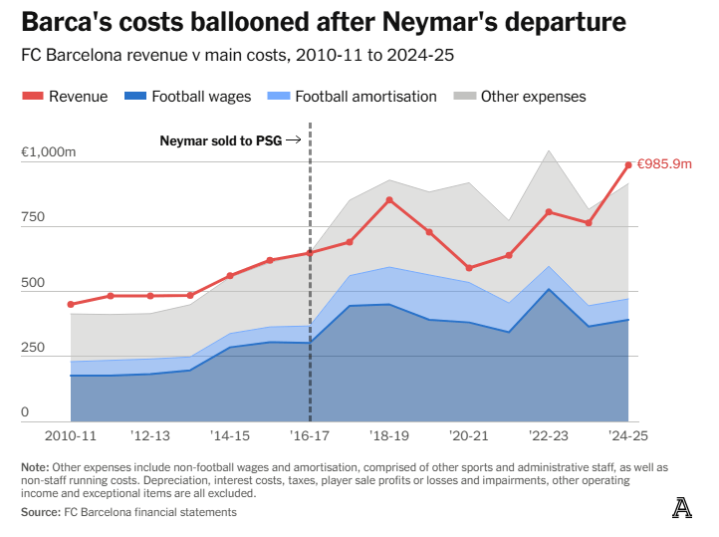
(Regarding Neymar’s past, I have already posted it, so I won’t repeat it)
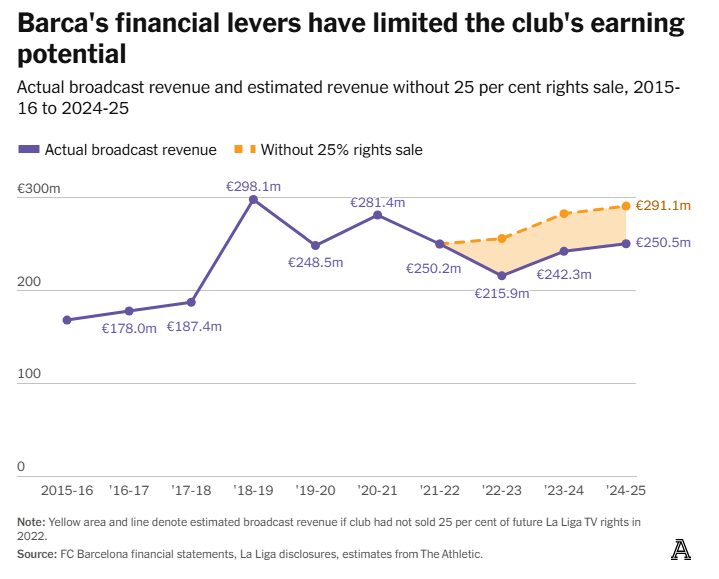
For Barcelona, their biggest financial problem comes from the stadium.
In the first week of April 2014, FC Barcelona members held a historic vote.
More than 27,000 members (72% of those surveyed) voted in favor of the "New Barcelona Space" (NewEspaiBarca) project, which aims to improve and expand Barcelona's home stadium Camp Nou and its surrounding facilities.
In addition to the renovated football field, a new stadium (Palau Blaugrana) will also be built, where Barcelona's basketball, handball, hockey and futsal teams will compete.
All these and other works in the surrounding area are scheduled to be completed over four years, between May 2017 and March 2021. The "New Barcelona Space" project has a total investment of 600 million euros, and the funding sources are divided into three equal but different amounts:
200 million euros from the naming rights of the new Camp Nou stadium, 200 million euros from the club's positive operating cash flow, and 200 million euros from bank loans.
Nearly 12 years later, the project is still ongoing, but the cost has soared.
In 2021, when Laporta returned as chairman, the initial budget of 600 million euros was cancelled. At that time, the project had barely started, let alone been completed on schedule. Only the Johan Cruyff Stadium, which can accommodate 6,000 people, was completed. This new stadium is the home for the women's football team, reserve team and U19 youth team.
Later that year, members voted again on the financing plan for the "Barcelona Space" (EspaiBarca) project, and approved Laporta's plan with a higher number of votes than the first vote in 2014.
The new spending limit approved for the project is 1.5 billion euros, 1.5 times the previously agreed budget, and the cost of the Camp Nou stadium has more than doubled from the original 420 million euros.
After the new Barcelona Stadium and its surrounding supporting facilities are completed, the total cost will reach 420 million euros, much higher than the previous 90 million euros. Even the funding for urban planning in the region has increased significantly, from 20 million euros to 100 million euros.
Four years later, this revised project is still behind schedule, and the cost is rising. In the 2022-23 season, Barcelona spent 106 million euros on the "Barcelona Space" (EspaiBarca) project, and an additional 322 million euros a year later. Last season, it invested 415 million euros.
As of the end of June 2025, this project has cost Barcelona 975 million euros (as shown in the figure below). Moreover, more funds will need to be invested in the future.
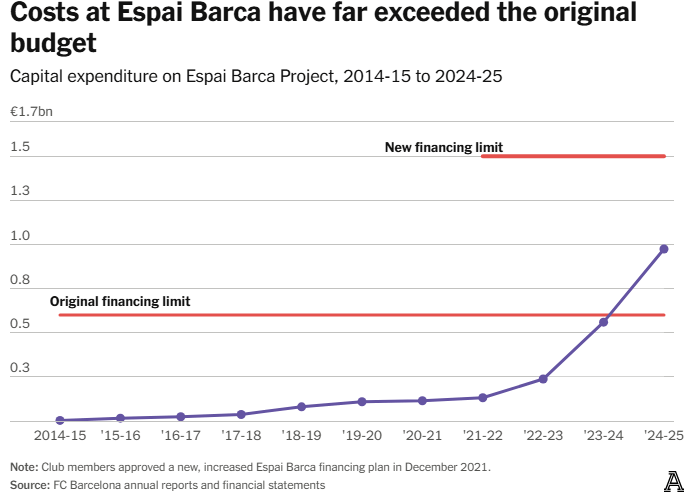
It is still unknown when the project will be completed. The refurbished Camp Nou was originally scheduled to be largely completed before the start of the season, but Barca are still pushing for a reopening, even with attendance limits.
Returning to the club’s iconic stadium this year is full of difficulties. The first two home games of the La Liga season had to be played at the smaller Johan Cruyff Stadium, and then Barcelona moved back to their temporary home, which was the venue for the 1992 Olympic Games.
Last week, the club announced that it would hold a public training session at Camp Nou this Friday, allowing up to 23,000 fans to enter the stadium "as part of the gradual reopening plan of the stadium."
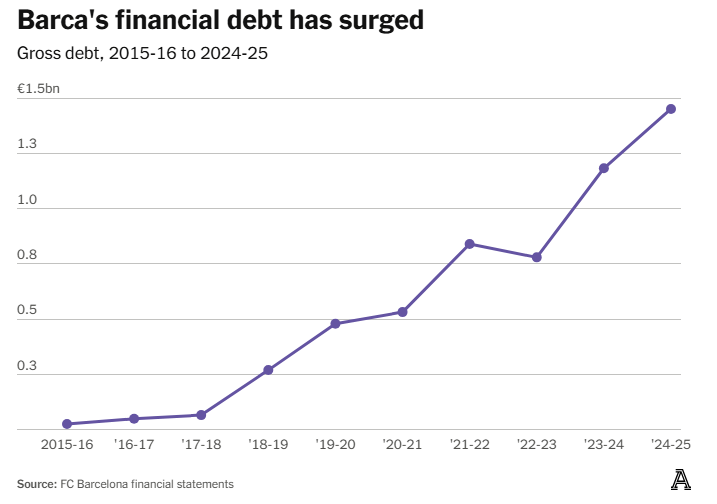
These delays compounded the club's financial losses. The cost of the Espai Barca project is approximately €1 billion, but this does not include the loss of revenue the club will suffer from moving away from the Camp Nou stadium.
Even determining specific debt figures is not easy.
A year ago, Barcelona's total debt was announced to be 1.81 billion euros, and this figure was also widely circulated. Two years ago, this figure was 1.62 billion euros. So, as the cost of the EspaiBarca project continues to rise, why is the latest figure lower than the previous two, only 1.45 billion euros?
The answer lies in changes in accounting methods.
The debt of the EspaiBarca project is held by a securitization fund established in 2023 to finance the project. In short, the fund mainly raises funds through debt and then transfers the funds to the club for the construction of Espai Barca.
In return, they will gradually repay these loans using the additional funds raised after the renovation of the Camp Nou stadium.
Previously, the fund was deemed to be controlled by FC Barcelona and therefore its assets and liabilities were included in FC Barcelona's consolidated financial statements. But the fund's activities are not limited to providing funds to clubs. The securitization fund raised more than 1 billion euros in loans when it was first established, far exceeding Barcelona's actual borrowing needs at the time.
Therefore, Barcelona's total debt last season included all borrowings from the securitization fund, regardless of whether these borrowings were passed on to the club.
This time, the new auditor determined that Barcelona did not actually control the fund, so its assets and liabilities should not be included in the club's consolidated financial statements. Therefore, only Barcelona's debt to the fund is currently included. As these debts are lower than the fund's total borrowings, Barca's total debt is down compared to the 2023-24 accounts.
But in fact, Barcelona's debt is still increasing. As the costs of the entire FC Barcelona stadium project continue to escalate until completion, it is expected that the entire debt of the fund will eventually appear on the club's books again.
Although the club expects revenue to exceed 1 billion euros in the 2025-26 season, they were in trouble again this summer due to Laliga registration issues.
In August, Laporta's board of directors used personal assets as guarantee to borrow 7 million euros, so that they could register Rashford and new goalkeeper Joan Garcia before the start of the new season.
It is vital to reopen the Camp Nou and return it to full capacity as soon as possible.
The amount of debt is huge, and while debt itself is not a bad thing, the club's poor financial performance in the past has undermined confidence in the future. About 424 million euros of debt for Barcelona's Espai Barca project was recently refinanced at a lower average interest rate of 5.19%, but this is still two percentage points higher than the 3.2% interest rate on Real Madrid stadium debt.
Such a huge debt will take decades to repay, and higher interest rates will affect the competitiveness of Barcelona and Real Madrid.
It is too early to say that Barcelona has recovered from the trough of a few years ago.
The delayed construction of the Camp Nou stadium is not a sign of smooth operation of the club; the current difficulties in complying with relevant regulations at home and abroad are also worrying; short-term liabilities still far exceed assets;
However, Laporta's bold strategy did work in some respects.
On the court, Barcelona regained its competitiveness and once again showed its enjoyment. Under the guidance of head coach Hansi Flick, they have a young team full of energy and potential. The obvious lesson - just as it was two decades ago - is that they should trust their youth system rather than spend extravagantly on signings.
source:7m vn sportRelated Posts
- Received a claim of 30 million! Portuguese media: Inter won the lawsuit and settled the transfer dispute with Sporting CP over Mario
- Next week s match against Barcelona! French media: Not only Vitinia, K77 was replaced by Paris due to thigh discomfort
- Unit: Decaitlare participated in some joint training and is expected to play in Juventus on the weekend
- Gallish questioned the referee: It is unheard of for a quick free kick to dye the yellow, Liverpool fans will blow it
- Reporter talks about the FA s accusation of Chelsea of failure to declare commission truthfully, the Blues advocate no competitive punishment
- Official: 29-year-old Turin striker Sanabria joins Cremona for permanent transfer
- Tonight s Hong Kong showdown! Golden Boot Ronaldo VS Champion Benzema! Saudi Super Cup semi-final focus game
- Media person: Liu Shaoziyang is the main candidate for strengthening the position of Guoan goalkeeper
- Overseas intelligence: Almaty 1-0 Olympia
- Zhuang Yushan scored 28 points! The young player performed well! The Chinese women s volleyball team magically reversed Germany 3-2!
Hot Posts
- Received a claim of 30 million! Portuguese media: Inter won the lawsuit and settled the transfer dispute with Sporting CP over Mario
- Next week s match against Barcelona! French media: Not only Vitinia, K77 was replaced by Paris due to thigh discomfort
- Unit: Decaitlare participated in some joint training and is expected to play in Juventus on the weekend
- Gallish questioned the referee: It is unheard of for a quick free kick to dye the yellow, Liverpool fans will blow it
Recommend

The countdown to the return of Real Madrid captain! Is it really healed after 8 months of serious injury?

Director Naples: Definitely finalized De Bruyne, does Conte stay? He has no competitors
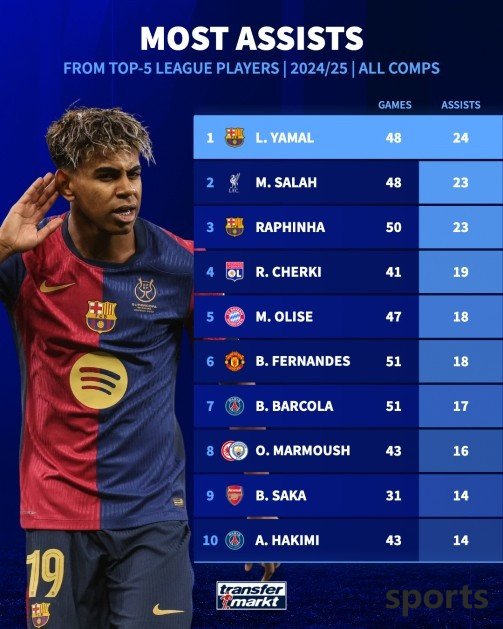
The total assist list of players in the top five leagues this season: Yamal ranked first 24 times and Salah Rafinia 23 times

17-year-old Barcelona midfielder star emerged, two Premier League giants scrambled

Inter Milan chooses one of three defenses, former Serie A MVP, PK two major stars in Ligue 1 and Bundesliga

A 2-1 game made the crazy South American fans silent, Mueller and the beautiful referee talked and laughed

German media: Bayern reserves a special budget for Walter Mad and may also sign a replacement for Koeman

The average goals per game of the five major league teams this season: Bayern leads the list with 3.64 goals, followed by Inter Milan and Real Madrid